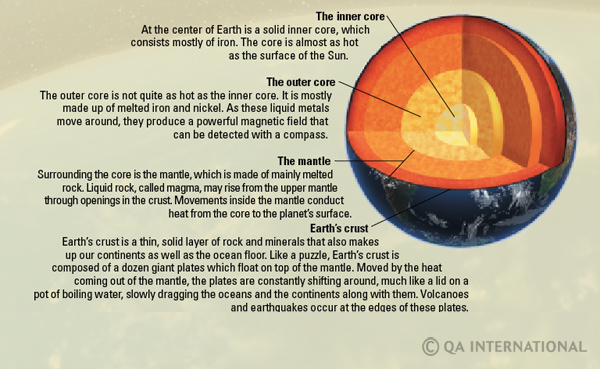
Earth—the exceptional blue planet
Like Mercury, Venus, and Mars, Earth is a rocky planet. It is, however, larger and much more active than its neighbors. Along with one of Jupiter’s natural satellites Io, it is one of the only places in the solar system confirmed to have active volcanoes. Earth is actually unique for many other reasons: It is the only planet with plenty of water, an oxygen-rich atmosphere to protect it, and an ability to support life. It is also the only planet that has not been named after a Greek or Roman god. The name “Earth” simply comes from era, the Greek word for earth. Our planet might just as easily have been called “Ocean,” however, because the seas and oceans cover more than two-thirds of its surface. The blue planet travels around the Sun accompanied by a large natural satellite, our Moon.
Round or flattened?
The Greek philosopher Aristotle proved more than 2,300 years ago that Earth was round. One of the ways he demonstrated this was by pointing out how Earth’s shadow was always perfectly circular during a lunar eclipse. We now understand that the planet is not perfectly round, but rather slightly flattened at the poles. Scientists call this particular shape a geoid.
A changing landscape
When Earth was formed 4.6 billion years ago, it was a huge ball of melted rock. As the young planet slowly cooled, the crust began to change into a solid. Not long afterward, meteorites, which are blocks of rocks and metals that fall from space, hit the newly formed crust, scarring it with craters. Over thousands of years, winds and rains managed to erase most of these scars. Through this same process, called erosion, rivers dug valleys and ocean waves carved out the shoreline. Today, erosion continues to wear down Earth’s rocky surface, gradually reshaping our planet’s features. Earth’s appearance can also be changed much more quickly, by earthquakes and volcanoes.
At the center of Earth
Earth is mainly made of iron, oxygen, and silica, a substance found in sand. These different materials are not distributed evenly throughout the planet. By studying the way seismic waves (tremors from earthquakes) travel through the ground, scientists have determined that our planet is made up of several main layers.

Earth in motion
Like a giant spaceship carrying people, animals, plants, and millions of tiny living organisms, Earth hurtles through space at a speed of more than 60,000 miles per hour (100,000 km/h). Fortunately, we don’t feel it, because everything on the planet is moving at the same speed— the ground we walk on, the houses we live in, and every object around us. Earth makes a complete trip, or revolution, around the Sun in 365 1/4 days. It is during this yearlong orbit that Earth’s four seasons occur, one after the other. Like the other planets in the solar system, ours also spins, or rotates. One complete rotation takes almost 24 hours. This explains the alternation of day and night.
Day and night
Every day we watch the Sun “rise” in the east, move across the sky, and “set” in the west. In fact, the Sun is not moving at all; it is Earth that is moving. Earth makes a complete rotation in almost 24 hours. Because Earth rotates while it travels around the Sun, every part of the planet gets its share of daylight and darkness. It is daytime on the side of Earth that is facing the Sun, and nighttime on the opposite side. Scientists have calculated that Earth’s rotation is slowing down by one second every 50,000 years. At this rate, in 5 billion years an Earth day will last 48 hours instead of 24 hours. It will be twice as long!
The cycle or the seasons
Seasons are caused by the changing amounts of solar energy that strike a part of Earth at different times of the year. Since Earth is slightly tilted to one side as it travels around the Sun, some areas of the planet receive more energy in the form of light and heat than others. Because the Sun’s rays strike Earth’s equator almost always directly, this area is the hottest. As we get farther away from the equator, the Sun’s rays hit the ground less directly, at a more slanted angle. These areas experience colder temperatures. When the North Pole is tilted toward the Sun, it is summer in the north half, the Northern Hemisphere, and winter in the south half, the Southern Hemisphere. The opposite occurs when the South Pole is tilted toward the Sun.

Also see:
In the Visual Dictionary:
In the encyclopedic capsules :
- Earth: a rocky planet
- The phenomenon of the seasons
- The Moon, our own natural satellite
- Mountains: the top of the world
- The shoreline: between land and sea
- Our knowledge of geologic time
- Configuration of the continents
- The solar system
- The galaxies
In the ikonet games:
- Put it in its place!:




